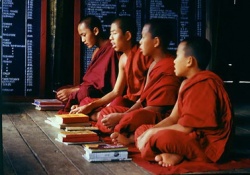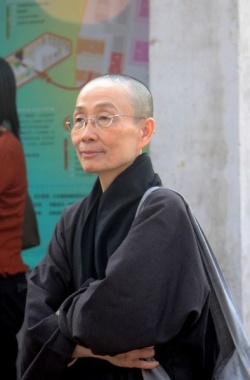Question of Origin
"Buddhist cosmology establishes the cycle of a universe in the following way: first there is a period of formation, then a period where the universe endures, then another during which it is destroyed, followed by a period of void before the formation of a new universe. During this void, the particles of space subsist, and from these particles the new universe will be formed. It is in these particles of space that we find the fundamental consubstantial cause of the entire physical world. If we wish to describe the formation of the universe and the physical bodies of beings, all we need do is analyse and comprehend the way in which the natural potential of different chemical and other elements constituting that universe was able to take shape from these space particles. It is on the basis of the specific potential of those particles that the structure of this universe and of the bodies of the beings present therein have come about."
If we accepted a beginning to consciousness, we would also have to accept that its cause has a beginning, a sudden cause which would have instantly produced consciousness; this would lead to a great many other questions. If consciousness had arisen without cause, or from a permanent cause, that cause would have to exist on. a permanent basis, always, or not exist at all, ever. The fact that a phenomenon exists intermittently proves that it depends on causes and conditions. When all the conditions are met, the phenomenon is produced. When those conditions are absent or incomplete, the phenomenon does not appear. As causes have no beginning and stretch back to infinity, the same thing must apply for living beings. Creation is therefore not possible.
Interest im the discoveries of modern astrophysics and the "Big bang" theory reveal both a great fascination in the cosmos and a probing interrogation by members of our generation into their origins, their destiny and the meaning of their existence. The "Big bang" theory has had a significant impact on our way of looking at matter and nature; it has introduced considerable conceptual innovations. The formation of the structures of the universe, which function in interdependence, and which new research continues to reveal, is a seemingly endless source of wonder. Like all spiritual traditions, Buddhism conveys a cosmogonic myth. And yet Buddhism rejects the idea of creation. Why?
Most Western scientists think that life and consciousness are a magnificent result of the universe's material evolution, and yet they know neither how nor why matter emerged in such a way as to fulfill the conditions necessary to engender life and consciousness. What they do know is that these conditions are very strict, yet have nevertheless been fulfilled in our universe in an astonishing way. You have a very different point of view on this subject. Would you therefore speak to us about consciousness in its relation to matter and the universe?
A: Why is there no creation possible in Buddhism? It has been said that one cannot find living beings at the becoming of the universe for the essential reason that causes have no beginning. If there were a beginning to the universe, there would also have to be a beginning to consciousness. If we accepted a beginning to consciousness, we would also have to accept that its cause has a beginning, a sudden cause which would have instantly produced consciousness; this would lead to a great many other questions. If consciousness had arisen without cause, or from a permanent cause, that cause would have to exist on. a permanent basis, always, or not exist at all, ever. The fact that a phenomenon exists intermittently proves that it depends on causes and conditions. When all the conditions are met, the phenomenon is produced. When those conditions are absent or incomplete, the phenomenon does not appear. As causes have no beginning and stretch back to infinity, the same thing must apply for living beings. Creation is therefore not possible.
Let us now consider a particular phenomenon, a glacier for example: it does indeed have a beginning. How was it created? The outside world appears as a result of the acts of sentient beings who use this world, These acts, or karmas, in turn originate in the intentions and motivations of those beings who have not yet taken control of their minds.
The "creator of the world," basically, is the mind. In the Sutras, the mind is described as an agent. It is said that consciousness has no beginning, but we must distinguish here between gross consciousness and subtle consciousness. Many gross consciousnesses appear as dependents of the physical aggregates, of the body. This is evident when you consider the different neurons and the functioning of the brain, but just because physical conditions are met does not mean that this is enough to produce a perception. In order for a perception which will have the faculty to reflect and know an object to arise, it must have a consubstantial cause. The fundamental consubstantial cause, of the same substance as its result, will in this case be the subtle consciousness. It is this same consciousness or subtle mind which penetrates the parental cells at the moment of conception. The subtle mind can have no beginning. If it had one, the mind would have to be born of something that is not the mind. According to the Kalacakra Tantra, one would have to return to the particles of space to find the fundamental consubstantial causes of the external physical world as well as of the bodies of sentient beings.
Buddhist cosmology establishes the cycle of a universe in the following way: first there is a period of formation, then a period where the universe endures, then another during which it is destroyed, followed by a period of void before the formation of a new universe. During this void, the particles of space subsist, and from these particles the new universe will be formed. It is in these particles of space that we find the fundamental consubstantial cause of the entire physical world. If we wish to describe the formation of the universe and the physical bodies of beings, all we need do is analyse and comprehend the way in which the natural potential of different chemical and other elements constituting that universe was able to take shape from these space particles. It is on the basis of the specific potential of those particles that the structure of this universe and of the bodies of the beings present therein have come about. But from the moment the elements making up the world begin to set off different experiences of suffering and happiness among sentient beings, we must introduce the notion of karma -- that is, positive and negative acts committed and accumulated in the past. It is difficult to determine where the natural expression of the potential of physical elements ends and the effect of karma -- in other words, the result of our past acts -- begins. If you wonder what the relation might be between karma and this external environment formed by natural laws, it is time to explain what karma is.
Karma means, first of all, action. We distinguish one type of karma which is of a mental nature, a mental factor of volition or intention. There also exist physical and oral karmas. To understand the connection between these physical, oral, or mental karmas and the material world, we must refer to the tantric texts. The Kalacakra Tantra in particular explains that in our bodies there are to be found, at gross, subtle, and extremely subtle levels, the five elements which make up the substance of the external world. It is therefore in this context, I believe, that we must envision the connection between our physical, oral, and mental karmas, and the external elements.


